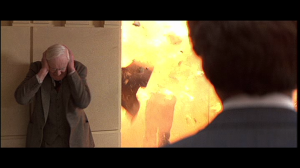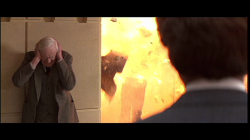USS Manley (DD 940)
On April 9, 1979 a fuel line ruptured in the boiler room aboard USS Manley (DD 940). An officer standing nearby was soaked with fuel which then burst into flames. LT Gilbert Johnson was burned over two thirds of his body as his polyester uniform melted to his skin and continued burning. Eight other Sailors in the boiler room received only minor burns. They were all wearing cotton, or cotton blend, uniforms. Three weeks after the fire LT Johnson died of his burns.
During a lawsuit against the manufacturer of the uniform, Peter Brown, a professor of textiles and clothing at the University of Minnesota said that the polyester uniform would be suitable for normal activities, but that “It does melt. It does ignite. It does continue to burn.” According to other depositions in the case the Navy certified the used of polyester uniforms in 1972 but never tested them for flammability. Despite the testimony, there is no indication that the Navy took action against the wear of 100% polyester uniforms aboard ship following the death of LT Johnson.
USS Conyngham (DDG 17)
In May 1990, a predawn fire killed the operations officer and injured a dozen sailors aboard USS Conyngham (DDG 17). The blaze forced the captain to evacuate the bridge and the combat information center while the crew battled the main engine-room fire and a series of secondary fires.
The fire erupted in the main boiler room at 5:35 a.m. as the 437-foot ship was sailing about 80 miles off the coast of North Carolina in what the Navy calls the Virginia Capes Operating Area, officials said.
“The fire spread to the combat information center spaces, which caused the captain to evacuate the combat information center and the bridge, temporarily leaving the ship without communications and dead in the water,” White House spokesman Marlin Fitzwater said.
The Conyngham’s skipper, Cmdr. W. R. Williams, reported that the main fire was extinguished within two hours but that the crew fought secondary blazes until noon.
USS Whidbey Island (LSD 41)
At 4 a.m. on October 5, 2010 a fire broke out in the deck department office aboard USS Whidbey Island (LSD 41). The fire burned for over 90 minutes, cutting off access to repair locker 2 and requiring assistance from neighboring ships and the base fire department before being put out. The fire was ultimately traced to the improper use and storage of linseed oil. As part of the investigation, the Naval Safety Center recommended that the new Navy Working Uniform, a 50/50 cotton/nylon blend, not be used by fire fighters or first responders. This recommendation was later modified to allow first responders to be in the NWU.
_____________________________________________________________________
In October 2012, the Navy conducted a seemingly unplanned and unrelated flammability test. The test, now much talked about, found that the NWU was not flame resistant, and when set alight would “burn robustly until consumed”.

In subsequent media releases the Navy disclosed that the requirement for a flame retardant uniform aboard ship had been rescinded in 1996 and that the NWU met current requirements for shipboard use. These comments are very similar to the Navy comments about the use of CNT uniforms aboard ship in 1979. Despite the fire onboard Manley, the Navy continued to allow the wear of CNT uniforms aboard ship until after the attack on USS Stark (FFG 37) in 1987. Corfam shoes and polyester uniforms were banned aboard ship following the attack and subsequent fires.
Now, these are three cases over almost forty years. There have been at least 60 major fires aboard ships and submarines since 1979. Fewer than two dozen Sailors were killed in those fires. One could easily make the case that fire occurs so rarely that a fire retardant uniform is unnecessary.
Yet, take a look at the time of day and circumstances of the fires listed here. Pre-dawn. Fires occur to their convenience and not ours and marginal increased cost of a fire retardant should not be outweighed by peacetime statistics. We fight like we train.
If we cannot equip our Sailors with a fire retardant or flame resistant uniform, at the very least the removal of a shipboard uniform that melts and burns until consumed should be an easy first step. It was done 25 years ago, we should be able to do it today.
CAPT Junge is a Naval War College Professor and career surface warfare officer with afloat service in frigates, destroyers, and amphibious assault ships. His afloat career culminated in command of USS Whidbey Island (LSD 41). Ashore he has served as an officer recruiter and with four different Washington DC staffs. A graduate of the US Naval Academy he also holds graduate degrees from the US Naval War College and The George Washington University.


I wonder… nomex flightsuits are flame retardant. Why would we all wear nomex gear? I’m told the PC crews used to wear them back in the SPECWAR days.
The crew of the MANLEY immediately went to heavy cotton jump suits in the main spaces. I had spoken with LT Johnson, a staff officer working on his command qualifications that day, just a couple of hours before the fire.
It’s sad that a man died wearing those ugly assed double knits in a main space. There is no place on a ship for a uniform that burns and or melts.
Yeah, regarding the fire on the Manley in 1979, I was assigned to the Manley as the replacement B Division officer in Feb 1980. Let’s set the record straight, the Navy DID indeed ban double knit uniforms from the engineering spaces aboard all ships. You could still wear them elsewhere, but nowhere in the engineering spaces.
When I was there on the Manley in ‘77, the only fires we had were guys lighting up joints and bowls on the fantail smoking good & plenty Mary Jane. The officers wouldn’t even bother us. We were “Stoned on the Bridge!!”
In the spring of 1977, there was an explosion in mount 52 that killed 3 gunner’s mates during refresher training while in Guantanamo Bay
LT Johnson was no longer attached to the Manley. He was just there to witness the light off of boiler plant #1
Clothing that was liable to melt and burn also caused injury to Royal Navy sailors in the Falklands War.
I was on Conygham DDG-17 who was assigned to a boiler room on where the fire started from 1980 to 1984 and the officers and Chiefs routinely War their double neck khakis in the engineering spaces. They also informed us at all the asbestos it had been removed 3 years prior to me going aboard, but I know better because I cut insulation off of things that had at least six layers of paint built up. I definitely was more than 3 years of built up